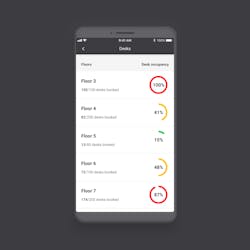Signify adds people distancing feature to its IoT software
With a larger question looming as to whether companies in a post-pandemic world will use commercial offices to the extent they have in the past, Signify has tweaked its lighting software to support social distancing for employees who are returning to conventional environments.
The Eindhoven company added a feature to Interact Office that allows users to set parameters such as, say, “six feet apart.” Interact Office’s existing Workspace app will account for that information as it provides real-time updates of office occupancy to employees’ phones. Employees can see which zones to avoid and which still have acceptable levels. An indoor navigation system can guide them to those areas if need be.
Likewise, Interact’s Space Management uses the parameters to help facility managers make decisions on office usage and layouts.
Interact is Signify’s brand of Internet of Things (IoT) lighting. It uses the lighting infrastructure to mount sensors and communication chips that gather data and send it off for use and analysis. Its wireless communication technologies can include visible light communications (VLC), which transmits bits and bytes via modulations in LED light frequencies. They can also be radio frequencies such as Bluetooth or Zigbee, using chips mounted inside or along luminaires. Interact can make use of Power over Ethernet (PoE), a wired technology that runs both electricity and data over the same cable to luminaires.
Signify offers various permutations of Interact aimed at different vertical markets including hospitality, retail, industry, sports, and others. Interact Office is targeted at commercial offices, such as at the Atea offices in Stavanger, Norway and the Grenzach-Wyhlen, Germany offices of Roche Pharmaceuticals.
Earlier this year, amid the coronavirus outbreak, Signify also introduced a matchbox-sized snap-in module of sensors for Interact office luminaires to help monitor health-related data such as temperature, humidity, and noise. Last month, again with wellbeing in mind, the company introduced a combination artificial skylight and circadian lighting system.
And to help address concerns over IoT security, Signify recently announced that German testing company DEKRA has validated Signify’s IoT lighting as secure.
CEO Eric Rondolat has identified the global economic slowdown as an opportunity to educate customers about IoT lighting — something the industry needs as the concept has been slower to catch on than it would prefer. He has also noted that companies are using the downtime to carry out office refurbishments including lighting retrofits and upgrades. And he has stepped up the development of disinfection lamps using ultraviolet technology.
Still, uncertainty surrounds the general future of commercial office lighting, as the remote home working that has defined practices during the health pandemic could take hold as a new normal.
Jes Staley, the CEO of Barclays Bank, noted in late April that “the notion of putting 7000 people in a building may be a thing of the past.” Twitter has told its employees that they can work from home “forever,” and Google and Facebook have for now told employees they can work from home through the end of the year.
MARK HALPER is a contributing editor for LEDs Magazine, and an energy, technology, and business journalist ([email protected]m).
For up-to-the-minute LED and SSL updates, why not follow us on Twitter? You’ll find curated content and commentary, as well as information on industry events, webcasts, and surveys on our LinkedIn Company Page and our Facebook page.

Mark Halper | Contributing Editor, LEDs Magazine, and Business/Energy/Technology Journalist
Mark Halper is a freelance business, technology, and science journalist who covers everything from media moguls to subatomic particles. Halper has written from locations around the world for TIME Magazine, Fortune, Forbes, the New York Times, the Financial Times, the Guardian, CBS, Wired, and many others. A US citizen living in Britain, he cut his journalism teeth cutting and pasting copy for an English-language daily newspaper in Mexico City. Halper has a BA in history from Cornell University.





